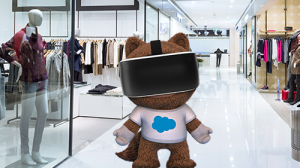The future of retail is a dynamic and exciting one – rooted in the reimagination of engagement channels, disruption of business models, and innovations in technology.
Brands and retailers will compete with each other to redefine customer experience (CX) and engagement strategies. Digital channels will continue to be primary modes of customer engagement, inspiration, information and purchase; however, physical stores aren’t going anywhere. Instead, the store of the future will capitalise on tech advancements to deliver ‘retailtainment’ – the coming together of shopping experiences and entertainment.
Understanding experiential retail and why it’s gaining traction
Experiential retail, as the name suggests, focuses on experience-building in brick and mortar (physical/offline) stores. It hinges on the premise that ‘touch and feel’ or visual and sensory delights go a long way in engaging shoppers and enhancing their experience. There’s something about being able to touch a product — to hold it, see its size, feel its weight, and inspect its quality — that consumers crave.
Experiential retail gives shoppers a reason to interact and spend more time with a brand, even if they aren’t buying its products. Not only does that enhance brand recall, but it also boosts consumer willingness to eventually try the company’s products.
Today’s customers value experience just as much as quality and value. In fact, in our most recent State of the Connected Customer report, 88% of customers say the experience a company provides is as important as its products or services — the highest it’s been since Salesforce began tracking customer sentiment.
With that in mind, stores are transforming from shopping destinations to experience centres. Many are building creative experiences in the form of digital signages, gamification, pop-ups, experimentation with AR-VR led trials, and cashier-less checkouts.
Athleisure brand, Puma, provides state-of-the-art offerings at its experiential stores – including F1 simulators and a personalisation studio with a cutting-edge embroidery and printing machine. The stores also showcase interactive retail screens and wall art that doubles up as a game.
Enrich, a beauty salon chain across India, launched their first, all-inclusive beauty store in Mumbai last year. Replete with beauty bars that provide personalised skincare consultations, the store also offers mini-makeovers and makeup tutorials.
Meanwhile, online furniture retailer, Pepperfy, launched a series of concept stores under the name ‘Studio Pepperfry’. Managed by interior design professionals, Pepperfry experience centres offer customers free consulting for their home interior needs.
These approaches to experiential retail yield many benefits:
- Greater brand engagement with communities and individuals
- Personalised shopping experiences that improve brand loyalty
- Increased store traffic
- A way to test new concepts, and gain direct feedback from customers
- The ability for customers to touch and see products in person, resulting in potentially more referrals and word-of-mouth marketing
Technology: The foundation of an immersive and interactive CX
While shopper sentiment and behaviours are evolving, the demand for intimate and engaging shopping experiences remains strong. Retailers are creating more involved and sensorial CXs through technology-based innovations such as:
- Contactless shopping – Self-service kiosks and contactless check-outs bring the convenience of online shopping to a physical store.
- Digital displays – Interactive screens provide product information, comparisons, and reviews, thus saving shoppers time.
- Endless aisles – Tech-enabled in-store kiosks support omni-channel fulfilment by enabling buyers to browse and order products that aren’t available in-store.
- AI-ML – Artificial intelligence and machine learning, combined with predictive analytics, help personalise the shopping experience (e.g., guiding shoppers to the store section that stocks products of their choice or size).
- AR-VR – Augmented and virtual reality are the building blocks behind several unique experiences like product demos, smart mirrors, and virtual assistants providing fashion advice. Meanwhile, 3-D body mapping and try-on tech gets shoppers to experience a look created just for them in real time.
Building a winning experiential retail proposition
Experiential retail has found its way into many product categories, including home décor, fashion, accessories, athleisure, sportswear, and beauty. Here’s how you can create a successful experiential retail experience:
- Harness consumer data: If you’re a retailer, you probably have more data than ever on store footfall, consumer behaviours, and responses to product displays. The more you use this data to know your customers, the better the retail experiences you create.
- Focus on lead generation: Customers may not always purchase products in-store. But with innovative store layouts and concepts, you can trigger their shopping journey, and incentivise them to continue it online. The objective of experiential retail is to leverage offline channels as the start of a long-term omni-channel engagement.
- Personalise engagement: Look at where your customers are spending more time in-store. Keep track of the products they’re asking about. Then, use this data to curate resources, information, and products that the customer might be interested in. This approach of personalising experiential retail can earn you significant brownie points.
- Be agile: How shoppers spend their time in-store is evolving. So, keep your engagement strategies flexible. Consider investing in pop-ups and rotating concepts that can help you test new concepts, and enter new markets faster.
- Identify and reward your ‘hero’ customers: Exclusive experiences are a great way to reward and build a loyal customer base. Give your top-tier customers first access to curated styles, information, perks, separate store areas, and portfolios. This paves the way for immersive brand-relevant experiences that customers will love.
- Create an integrated tech lens: Find ways to integrate physical and digital shopping experiences. Use technology to build a single source of customer truth across channels. That way, wherever customers interact with your brand – be it in-store or online – they get to enjoy a seamless phygital experience across touchpoints.
How can Salesforce help brands succeed at experiential retail?

- Enable contactless engagement – Since the pandemic, contactless payments and order fulfilment have become increasingly popular. With Salesforce Quick Start Commerce Solutions, you can enable shoppers to simply walk into your stores and pick up their orders, or take advantage of curbside delivery. Meanwhile, the Salesforce product configurator offers beautiful 3D and augmented reality product experiences like virtual try-ons. So, shoppers can find the perfect product match.
- Personalise in-store conversations -With Salesforce Customer 360, you get a complete view of customers across online and offline channels. So, as soon as they walk into your store, you can pull up their details, including past purchases, unbought items in online carts, loyalty program tier, and reward points. These insights help you deliver a more personalised and contextual customer experience in-store. It also helps you orchestrate seamless shopping journeys across offline and online touchpoints.
- Improve merchandise visibility – When inventory dwindles, stores need to bring in more products as fast as possible. Salesforce provides a complete view of store and digital inventory, as well as a connected partner management solution that helps you work directly with suppliers in real time to procure new supplies.
- Deliver omni-channel shopping experiences with endless aisles – Salesforce’s endless aisle solution helps you extend digital commerce into the store. So, you no longer lose sales if products are not available in-store. With Endless Aisle, you can give customers limitless product options, including online-only products. Also offer multiple order fulfilment options through Endless Aisle’s integration with Commerce Cloud Order Management
The way forward
Experiential retail isn’t just a buzz word or a fad – it is the future of retail as we know it. Given the meteoric rise of online shopping, customers may not always purchase in-store. However, they will still value real-world interactions with brands. That said, the nature of these interactions will change. So also will the retail store’s role in the customer journey.
The best experiential retail strategies will focus on delivering memorable and repeatable shopping experiences that drive long-term value and relationships.




























